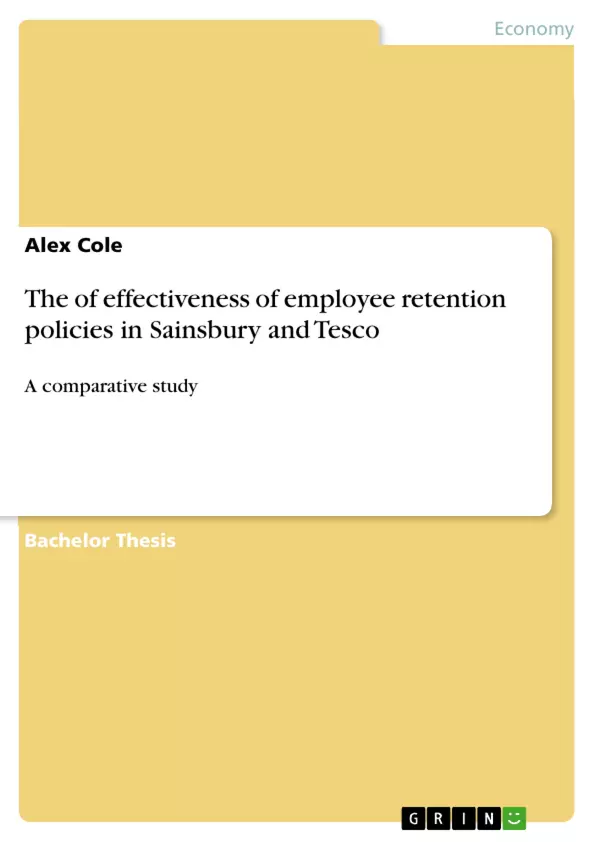
The of effectiveness of employee retention policies in Sainsbury and Tesco
Bachelorarbeit, 2012
62 Seiten, Note: A
Leseprobe
Table of Contents
- Chapter One: Introduction
- 1.1 Introduction
- 1.2 Background of Study
- 1.3 Purpose and Aim of Study
- 1.4 Objectives of Research
- 1.5 Research Question
- 1.6 Organization Overview
- 1.7 Significance of Study
- 1.8 Overview of Chapters
- 1.9 Summary of Chapter
- Chapter Two: Literature Review
- 1.1 Introduction
- 1.2 What is Employee Retention?
- 1.3 The Importance of Human Capital
- 1.4 Why is Employee Retention Important?
- 1.5 Employee Retention Strategies
- 1.6 Summary of Chapter
- Chapter Three: Methodology
- 3.1 Introduction
- 3.2 Defining Research
- 3.3 Research Philosophy
- 3.4 Research Approach
- 3.5 Research Method
- 3.6 Data Collection Tools
- 3.7 Population and Sampling
- 3.8 Data analysis method
- 3.9 Ethical Considerations
- 3.10 Summary of Chapter
- Chapter Four: Data Findings and Presentation
- 4.1 Introduction
- 4.2 Findings of questionnaire
- 4.3 Summary of Chapter
- Chapter Five: Data Analysis
- 5.1 Introduction
- 5.2 Analysis of Results
- 5.3 Summary of Chapter
Objectives and Key Themes
This research aims to compare the employee retention practices of Tesco and Sainsbury in the United Kingdom using a triangulation methodology incorporating qualitative and quantitative data. The study seeks to determine which company is more effective in retaining employees and identify the key factors contributing to their respective success or failure in this area.
- Comparative analysis of employee retention strategies in Tesco and Sainsbury.
- Identification of effective and ineffective employee retention practices.
- Assessment of the impact of various factors (e.g., compensation, management support, work environment) on employee retention.
- Determination of the relative effectiveness of short-term versus long-term retention strategies.
- Recommendations for improving employee retention practices in Sainsbury.
Chapter Summaries
Chapter One: Introduction: This chapter sets the stage for the research by introducing the importance of employee retention in human resource management. It provides background information on the competitive landscape and the challenges organizations face in retaining key employees, particularly in the context of a dynamic business environment. The chapter also outlines the research aims, objectives, questions, and significance, along with an overview of the organizational context and a brief summary of the subsequent chapters.
Chapter Two: Literature Review: This chapter explores existing literature on employee retention, defining the concept and highlighting its significance for organizational success. It examines the importance of human capital and explores various employee retention strategies, providing a theoretical framework for understanding the research questions. The chapter synthesizes existing knowledge on employee retention strategies to form a basis for comparison and analysis in later chapters.
Chapter Three: Methodology: This chapter details the research design and methods used in the study. It describes the research philosophy, approach, and methods employed in collecting and analyzing data. This includes a discussion of the sampling technique, data collection tools (specifically a close-ended questionnaire), and the ethical considerations involved in the research. The chapter justifies the methodological choices made and explains how these choices contribute to the reliability and validity of the research findings.
Chapter Four: Data Findings and Presentation: This chapter presents the findings from the survey administered to employees of Tesco and Sainsbury. It lays out the raw data from the questionnaire, providing a descriptive overview of the responses collected from the employee sample. This chapter serves as the basis for the more in-depth analysis in the following chapter.
Chapter Five: Data Analysis: This chapter analyzes the data presented in Chapter Four, focusing on specific factors related to employee retention such as training, promotion opportunities, performance appraisal, salaries, benefits, relationships with colleagues, job security, working environment and management role. It compares Tesco's and Sainsbury's performance in each of these areas and identifies statistically significant differences. This chapter is crucial for understanding the reasons behind the differences in employee retention rates between the two companies.
Keywords
Employee retention, Tesco, Sainsbury, human resource management, quantitative research, qualitative research, employee survey, retention strategies, competitive advantage, UK, comparative study.
Frequently Asked Questions: Comprehensive Language Preview
What is this document about?
This document provides a comprehensive preview of a research study comparing the employee retention practices of Tesco and Sainsbury in the United Kingdom. It includes a table of contents, objectives and key themes, chapter summaries, and keywords. The study utilizes a mixed-methods approach (both qualitative and quantitative data).
What are the main objectives of the research?
The research aims to compare employee retention strategies at Tesco and Sainsbury, identify effective and ineffective practices, assess the impact of various factors (compensation, management support, work environment) on retention, determine the effectiveness of short-term versus long-term strategies, and offer recommendations for improving Sainsbury's retention practices.
What methodology is used in this research?
The research employs a triangulation methodology, combining qualitative and quantitative data. The quantitative data is collected through a close-ended questionnaire. The research design details are described in Chapter Three, including the research philosophy, approach, method, sampling technique, data collection tools, and ethical considerations.
What are the key themes explored in the research?
Key themes include comparative analysis of employee retention strategies in Tesco and Sainsbury, identification of effective and ineffective practices, the impact of factors like compensation and work environment on retention, and the comparison of short-term and long-term retention strategies.
What data is analyzed in the research?
The research analyzes data collected from a survey administered to employees of Tesco and Sainsbury. Chapter Four presents the raw data, while Chapter Five analyzes the results focusing on factors such as training, promotion, performance appraisal, salaries, benefits, relationships with colleagues, job security, working environment, and management role. The analysis compares Tesco's and Sainsbury's performance in each area and identifies statistically significant differences.
What are the key chapters and their contents?
The study is organized into five chapters: Chapter One (Introduction), Chapter Two (Literature Review), Chapter Three (Methodology), Chapter Four (Data Findings and Presentation), and Chapter Five (Data Analysis). Each chapter summary is provided in the document preview. The introduction sets the stage and outlines the research objectives, the literature review examines existing research on employee retention, the methodology chapter details the research design, the data findings chapter presents the survey results, and the data analysis chapter interprets those results.
What are the key findings (in brief)?
The specific findings are detailed in Chapters Four and Five. Chapter Four presents the raw data from the employee survey, and Chapter Five provides an in-depth analysis comparing Tesco and Sainsbury's employee retention practices across various factors and identifies statistically significant differences.
What are the key words associated with this research?
Keywords include: Employee retention, Tesco, Sainsbury, human resource management, quantitative research, qualitative research, employee survey, retention strategies, competitive advantage, UK, comparative study.
For whom is this research intended?
This research is intended for academic use, focusing on the analysis of themes related to employee retention strategies within a comparative business context.
Details
- Titel
- The of effectiveness of employee retention policies in Sainsbury and Tesco
- Untertitel
- A comparative study
- Hochschule
- The University of Liverpool
- Note
- A
- Autor
- Alex Cole (Autor:in)
- Erscheinungsjahr
- 2012
- Seiten
- 62
- Katalognummer
- V212292
- ISBN (eBook)
- 9783656404484
- ISBN (Buch)
- 9783656405382
- Dateigröße
- 1340 KB
- Sprache
- Englisch
- Anmerkungen
- Very well presented
- Schlagworte
- sainsbury tesco
- Produktsicherheit
- GRIN Publishing GmbH
- Preis (Ebook)
- US$ 32,99
- Preis (Book)
- US$ 43,99
- Arbeit zitieren
- Alex Cole (Autor:in), 2012, The of effectiveness of employee retention policies in Sainsbury and Tesco, München, Page::Imprint:: GRINVerlagOHG, https://www.diplomarbeiten24.de/document/212292
- Autor werden
- Ihre Optionen
- Vertriebskanäle
- Premium Services
- Autorenprofil
- Textarten und Formate
- Services für Verlage, Hochschulen, Unternehmen

- © GRIN Publishing GmbH.
- Alle Inhalte urheberrechtlich geschützt. Kopieren und verbreiten untersagt.
- info@grin.com
- AGB
- Open Publishing
Der GRIN Verlag hat sich seit 1998 auf die Veröffentlichung akademischer eBooks und Bücher spezialisiert. Der GRIN Verlag steht damit als erstes Unternehmen für User Generated Quality Content. Die Verlagsseiten GRIN.com, Hausarbeiten.de und Diplomarbeiten24 bieten für Hochschullehrer, Absolventen und Studenten die ideale Plattform, wissenschaftliche Texte wie Hausarbeiten, Referate, Bachelorarbeiten, Masterarbeiten, Diplomarbeiten, Dissertationen und wissenschaftliche Aufsätze einem breiten Publikum zu präsentieren.
Kostenfreie Veröffentlichung: Hausarbeit, Bachelorarbeit, Diplomarbeit, Dissertation, Masterarbeit, Interpretation oder Referat jetzt veröffentlichen!
- GRIN Verlag GmbH
-
- Nymphenburger Str. 86
- 80636
- Munich, Deutschland
- +49 89-550559-0
- +49 89-550559-10
- info@grin.com
-










Kommentare